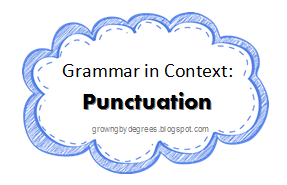The
goal in teaching language arts is to improve a student's ability to
listen, speak, read, and write. Tucked in the fine print are skills
which include at least the following:
- Grammar
- Vocabulary
- Spelling
How do you ensure you cover these skills with your students?
One way is to buy a workbook, one for each skill, one for each kid, and assign pages.
If they faithfully do a page or two a day in each book, they will
likely advance to the next level by the end of the school year.
Advantages:
- Mom and students know exactly what is required each day.
Disadvantages:
- Boring!
- It's easy to get bogged down with the habit of filling in paperwork, forgetting that there is an ultimate goal of learning!
- Nothing is really required of the student, other than perseverance.
- Students don't take pride in their work.
- After all those pages are completed, what then? The books likely end up in the trash.
Maybe I'm biased, but those lists are painfully lopsided.
What is another approach to achieve the same goal?
How about learning the skills in context?
When my girls were little and
many of their little friends were filling in their workbook pages, my
girls were writing. Writing in portfolders. Writing in blank books.
Writing stories. Writing journal entries. Writing. Writing. Writing.
They were also reading. Reading fiction. Reading non-fiction. Listening to me read fiction and non-fiction. Reading. Reading. Reading.
How
did they learn spelling, vocabulary, and grammar? They learned these
skills through reading and writing. As they read--and heard me
read--quality literature, they absorbed new vocabulary, proper grammar,
and correct spelling. As they wrote, they applied what they absorbed,
refining their understanding on assignments in which they were
personally invested. They learned early that writing is a process, that
their first draft is rarely their last.
Advantages:
- Students get to think.
- Creativity can leak out in all directions.
- They have final products they can celebrate and share with others.
- They are motivated because they have a goal in view.
- Because they are able to express themselves, they realize they are a vital part of the learning process.
- The teacher can inspire a love of learning.
- Students learn how to learn.
- One assignment can serve a range of ages and abilities.
- Supplies are simple and inexpensive: paper, pencils, and time, although a computer does make revisions easier.
Disadvantages:
- Mom may have to think of or find ideas to spark creativity.
- If students are used to filling in pages, they may initially resist having to think and create.
- If Mom doesn't feel comfortable giving feedback, she may need a writing mentor to help her students.
Again, I may be biased, but I like that list better!
The
moms of my girls' little friends feared a couple of things about
ditching their workbooks: one was possible gaps; the other was
standardized tests.
Through a methodical system, your students may be exposed to every jot and tittle of every skill, but when you isolate the skills from real life learning, do children actually know how to apply them?
From
what I have read and seen firsthand, the answer is usually no. In my
first classroom experience, my eighth graders came to me engorged from a
steady diet of grammar instruction the prior year. I was happy because I
could feed them something different. We could work on writing,
incorporating grammar instruction as needed. What I quickly discovered
was that, despite learning from an excellent teacher, not only did the
kids still not understand or remember the grammar they had learned from her, they also didn't know how to write. Even in a traditional classroom setting, these kids had huge gaps.
And
testing? At least in our case, my girls have always tested very high in
language arts. Through consistent drafting, revising, and editing, they
learned the nuts and bolts of the English language and were able to
choose the best answer on the test most of the time.
I
know writing is on the top or toward the top of most homeschooling
moms' I'm-not-sure-I-can-do-that-well list. If that describes you,
you're the one who is inspiring me to build this site post by post. I
want to give you concrete writing ideas, tips, and resources to ensure
you're covering the whole language arts package.
If you need a few workbooks for security, it's okay, but I encourage you to step out and give real reading and writing a whirl.
Because it's fun, you may fear you're missing something, but let me
assure you: you're nurturing thinkers, students who can confidently
listen, speak, read, and write. With those tools, think of what your
kids can accomplish!


































